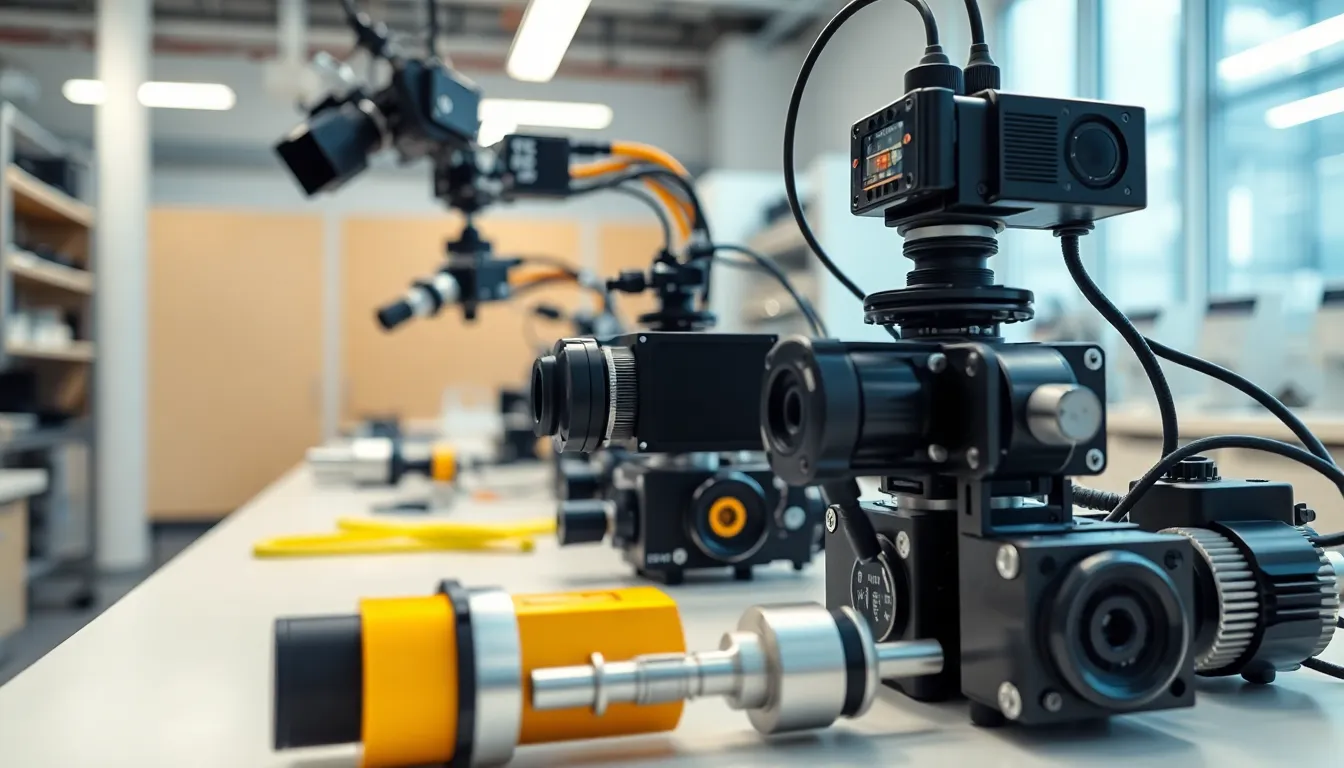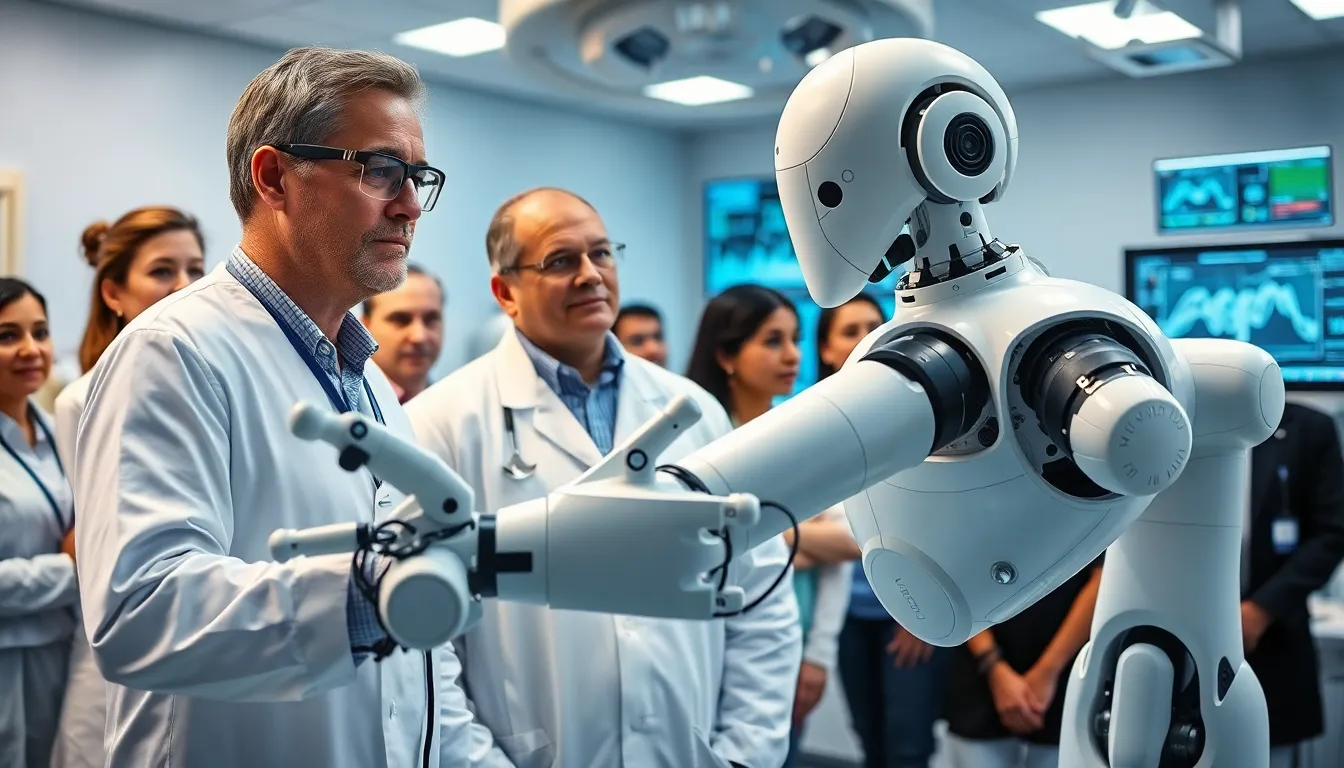In a world increasingly driven by technology, intelligent robot systems are reshaping industries and everyday life. These advanced machines are designed to learn, adapt, and perform tasks that once required human intelligence, making them invaluable assets in sectors like manufacturing, healthcare, and logistics. As they evolve, their capabilities expand, leading to unprecedented efficiency and innovation.
The integration of artificial intelligence and robotics is not just a trend; it’s a revolution. From autonomous vehicles navigating city streets to robots assisting in surgical procedures, intelligent robot systems are pushing the boundaries of what’s possible. As they become more prevalent, understanding their potential and implications becomes essential for businesses and society alike.
Table of Contents
ToggleOverview of Intelligent Robot Systems
Intelligent robot systems integrate artificial intelligence and robotics to perform complex tasks autonomously. These systems can analyze data, learn from experiences, and make decisions without human intervention. They exhibit capabilities such as vision, perception, and natural language processing, enhancing their effectiveness across various environments.
Key Components of Intelligent Robot Systems
- Sensors: Sensors collect real-time data from the robot’s surroundings. Examples include cameras, LiDAR, and ultrasonic sensors that provide critical information for navigation and task execution.
- Actuators: Actuators enable movement and physical interaction with the environment. They convert electrical signals into motion, allowing robots to manipulate objects and perform specific functions.
- Artificial Intelligence: AI algorithms process data and facilitate learning. Machine learning and deep learning enable robots to adapt to new situations and improve their performance over time.
- Control Systems: Control systems govern the behavior of robots. They ensure precise movement and task execution by continually adjusting based on feedback from sensors.
Applications of Intelligent Robot Systems
- Manufacturing: Intelligent robots enhance production efficiency by automating assembly lines. They increase precision and reduce errors, leading to higher output.
- Healthcare: Surgical robots assist in complex procedures. Their accuracy and minimally invasive techniques improve patient outcomes and reduce recovery times.
- Transportation: Autonomous vehicles rely on intelligent robot systems for navigation and safety. They analyze real-time data to make driving decisions, improving traffic management.
- Service Industries: Intelligent robots have begun to transform customer service. They handle inquiries and provide assistance in retail environments, enhancing customer experience.
Challenges and Considerations
- Ethical Implications: The rise of intelligent robots raises ethical questions about job displacement and decision-making processes. Considerations regarding accountability and safety are crucial.
- Technological Limitations: Current AI and robotics technology has limitations. Issues such as computer vision accuracy and real-time processing capabilities require further development.
- Regulatory Frameworks: Effective regulations are necessary to manage the deployment of intelligent robot systems. Establishing guidelines can enhance safety and ensure responsible usage.
Intelligent robot systems continue to evolve, demonstrating significant potential across various sectors. They reshape traditional processes and encourage new innovations that influence daily life and industry efficiency.
Components of Intelligent Robot Systems

Intelligent robot systems comprise several key components that work together to enable autonomous operation. These components include sensors, actuators, AI algorithms, and control systems, each playing a crucial role in the system’s functionality.
Sensors and Actuators
Sensors collect data from the environment, providing vital information for decision-making. Common types of sensors include:
- Cameras: Capture visual data for object recognition and navigation.
- Lidar: Measures distances using laser light, creating detailed maps of surroundings.
- Ultrasonic Sensors: Detect obstacles by emitting sound waves and measuring their reflection.
- Infrared Sensors: Monitor heat and motion, useful for tracking and detection.
Actuators facilitate movement and manipulation by converting signals into physical actions. Types of actuators include:
- Electric Motors: Drive wheels, arms, or other components for precise control.
- Hydraulic Actuators: Utilize fluid power to exert force in heavy lifting or robust tasks.
- Pneumatic Actuators: Use compressed air for rapid movement in lighter applications.
Control Systems
Control systems are fundamental for managing the operations of intelligent robot systems. They utilize algorithms to process sensor data and determine the appropriate responses. Types of control systems include:
- Feedback Control Systems: Adjust actions based on real-time sensor feedback to optimize performance.
- Adaptive Control: Modify responses based on changing conditions or environments to enhance learning.
- Fuzzy Logic Controllers: Utilize fuzzy set theory to handle uncertainty, suitable for complex decision-making tasks.
These components work in synergy, enabling intelligent robot systems to perform tasks efficiently and effectively.
Applications of Intelligent Robot Systems
Intelligent robot systems have numerous applications across various sectors, enhancing efficiency and providing innovative solutions. Below are key areas where these systems demonstrate significant impact.
Industrial Automation
Industrial automation employs intelligent robot systems to streamline manufacturing processes. Tasks such as assembly, welding, painting, and quality control benefit from robotic automation, increasing precision and productivity.
- Robotic arms: These systems perform repetitive tasks with high accuracy, reducing human error.
- Collaborative robots (cobots): They work alongside human workers, enhancing safety and efficiency in shared environments.
- Data analysis: Intelligent robots gather and analyze data to identify production bottlenecks, facilitating ongoing improvements.
Healthcare
In healthcare, intelligent robot systems improve patient outcomes and operational efficiency. They assist in various applications, including surgical procedures, rehabilitation, and patient monitoring.
- Surgical robots: Systems like the da Vinci Surgical System provide minimally invasive options, enhancing precision and recovery times.
- Robotic exoskeletons: These devices aid in rehabilitation, enabling patients to regain mobility through powered support.
- Telepresence robots: They enable remote consultations, allowing healthcare professionals to interact with patients from different locations.
Autonomous Vehicles
Autonomous vehicles utilize intelligent robot systems to redefine transportation. These vehicles integrate multiple technologies for safe navigation and user convenience.
- Self-driving technology: Systems like lidar and radar detect obstacles and navigate roadways, enhancing driving safety.
- Traffic management: Intelligent algorithms optimize route planning, reducing congestion and travel time.
- Safety features: Autonomous vehicles incorporate features like automatic braking and lane-keeping assistance to prevent accidents.
Through these applications, intelligent robot systems drastically improve processes, enhance service quality, and create opportunities for innovation across industries.
Challenges in Intelligent Robot Systems
Intelligent robot systems face several challenges that hinder their widespread adoption and effectiveness. These challenges encompass technical limitations and ethical considerations impacting the development and implementation of such technologies.
Technical Limitations
Technical limitations considerably affect the performance of intelligent robot systems. Systems often encounter challenges in areas like sensory perception, processing power, and algorithm complexity.
- Sensory Challenges: Sensors, while crucial for environmental data collection, can struggle with accuracy in varied conditions. Poor lighting, weather, or complex environments often hinder the effectiveness of vision and perception systems.
- Processing Constraints: High processing demands can result in slower response times. Complex algorithms require significant computational resources, limiting real-time decision-making.
- Algorithm Bias: AI algorithms may exhibit bias if trained on unrepresentative data sets. This bias can lead to erroneous judgments in critical applications such as healthcare and autonomous driving.
- Integration Issues: Integrating various components, like sensors and actuators, into cohesive systems often presents challenges. Compatibility and communication between different technologies can hinder seamless operation.
- Energy Efficiency: Many intelligent robots operate on battery power, leading to limitations in operational time and capabilities. Energy-efficient designs are essential for enhancing their usability in various applications.
Ethical Considerations
Ethical considerations play a significant role in the deployment of intelligent robot systems.
- Job Displacement: Automation creates concerns around job displacement as robots replace human roles in industries. The potential for economic disruption raises questions about workforce retraining and support.
- Privacy Issues: Data collection by robots raises privacy concerns. The use of cameras and sensors must be managed to prevent unauthorized surveillance and data misuse.
- Decision-making Responsibility: Accountability in decisions made by autonomous systems generates debate. It remains unclear who is responsible in cases of failure or harm caused by robots.
- Bias and Fairness: Algorithmic bias can perpetuate existing inequalities. Steps must be taken to ensure fairness and impartiality in AI decision-making processes.
- Social Acceptance: Widespread acceptance of intelligent robots hinges on public perception and trust. Transparent communication regarding capabilities and limitations is necessary to alleviate fears and foster acceptance.
Future Trends in Intelligent Robot Systems
Intelligent robot systems will experience significant advancements in several areas over the next decade. These trends encompass developments in artificial intelligence, human-robot collaboration, and deployment in various sectors.
Enhanced AI Algorithms
Enhanced AI algorithms will drive smarter decision-making for robots, enabling them to understand complex environments. Machine learning models will evolve, processing vast datasets to improve task execution accuracy and adaptability. For instance, deep learning techniques will enhance object recognition capabilities, allowing robots to navigate more autonomously and efficiently.
Increased Human-Robot Collaboration
Increased human-robot collaboration will define future workplaces. Collaborative robots, or cobots, will work alongside humans, complementing skills and enhancing productivity. This synergy will promote safer working conditions and optimize workflows across industries like manufacturing, healthcare, and logistics. Cobots’ ability to learn from human interactions will streamline operations and reduce repetitive tasks.
Modular Robotics
Modular robotics will gain traction, allowing robots to adapt their designs for various applications. This approach will enable the creation of customizable robotic systems that can address specific tasks across industries. Modular components will provide flexibility and reduce costs associated with robotic systems, promoting widespread usage.
Autonomous Navigation
Autonomous navigation will improve dramatically, benefitting sectors such as transportation and delivery services. Intelligent robot systems will utilize advanced sensory input and real-time data processing to navigate complex environments safely. For example, delivery drones and autonomous vehicles will rely on sophisticated algorithms for route optimization and obstacle avoidance.
Advanced Sensor Integration
Advanced sensor integration will enhance the perception capabilities of intelligent robots. Next-generation sensors, including multispectral cameras and improved Lidar systems, will provide a comprehensive understanding of surroundings. This enhanced perception will support tasks ranging from precision agriculture to dynamic warehouse management.
Ethical and Social Considerations
Ethical and social considerations will gain prominence in the deployment of intelligent robot systems. Stakeholders must address job displacement issues alongside the implementation of robots. Creating policies that ensure workers’ rights and social acceptance will be crucial for smooth integration.
Regulatory Framework Development
Regulatory frameworks will develop to keep pace with rapid advancements in intelligent robotics. Establishing guidelines will ensure safety, privacy, and accountability in robotic systems. Collaboration among governments, industries, and researchers will facilitate the creation of standards that govern the ethical development of robotics.
These trends illustrate how intelligent robot systems will evolve, redefine industries, and reshape societal norms in the coming years. The integration of AI and robotics will cultivate opportunities while addressing key challenges to ensure future progress aligns with the highest ethical standards.
The evolution of intelligent robot systems marks a pivotal moment in technological advancement. These systems are not just enhancing efficiency in industries but also transforming daily life in profound ways. As they continue to integrate more advanced AI capabilities, their potential applications will expand even further.
Addressing the challenges and ethical considerations surrounding these technologies is crucial for responsible development. The collaboration between humans and robots will redefine workflows and improve safety across various sectors. With ongoing advancements in AI and robotics, the future promises a landscape where intelligent robots play an integral role in shaping innovation and societal norms. Embracing this change will be essential for harnessing the full benefits of intelligent robot systems.




